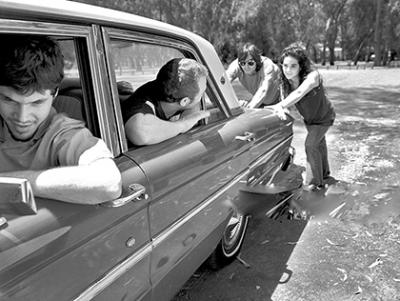
How we Learned to Drive on Vashon

“Push Mike, push harder or we’re not going to make it.” My little brother and I were pushing Mom’s 1941 Chev up the gravel road beside our peach orchard to get it away from the house before we could start it, so Mom and Dad couldn’t hear the engine.
We started the engine and headed for Wax Orchards, the longest straight stretch on Vashon and empty of cars at 3:00 AM.
“Go faster, go faster, “ Mike yelled, “We’re running out of road.” All six cylinders were singing as we hit 80 mph and the front end began to lope, like a leaping kangaroo. The front shock absorbers were kaput and I was having trouble steering the old Chev when we hit 92 mph and I started to brake for the curve up ahead. That’s as fast as we ever got her to go and the parents never found out or just didn’t tell us.
It really wasn’t Mom’s car and it sat in the same spot at Cove so long that the key was rusted in the ignition and Mom couldn’t get it out. Our Grandma Ollie had driven her old Chev from Spokane many years ago and now it was rusting away in our driveway. You could see the road going by through a hole in the floorboards and the trunk was so holy, things could fall through. The dogs didn’t seem to mind riding in the trunk when we took them hunting. Dad would stick a boat bumper in the crack when he let the trunk lid down, so the dogs could get air. Boots and Pan would jump right into the trunk, excited for the hunt.
In the 1950’s, we could still get a drivers license on Vashon, and the story went that if you could drive around the county jail three times and not kill any of Otto Therkelsen’s chickens, Sheriff Dan Star would give you a driver’s license. He really wasn’t a sheriff, but a deputy and we called him “chrome dome”, because his flashing red light was mounted right in the middle of the black paddy wagon. Our jail has only one cell and the building is used by the road crew for storage even today.
Cruising thru town looking for girls or revving our engines to hear the pipes roar was exciting. We learned how to turn the key off coming down a hill to make the car engine backfire, creating an explosion from the exhaust pipe. My 1936 Plymouth had a straight pipe and no muffler.
If the key was left off long enough, a great ball of fire would roll out, lighting up the Battery street tunnel and warming the feet of the guys in the rumble seat. Some guys added cut-outs in front of the muffler with spark plugs that would ignite the exhaust producing a surging flame from underneath the running boards.
Our Youth Center stood where the county library is now and we would congregate there to plan out the night’s adventures such as drag racing on the long straight stretches. I never raced; because my old Plymouth just couldn’t cut the mustard. One us would look for where Sheriff Starr might be hiding and then report back as to which end of the island he was on. We raced on either Wax Orchards Road or the straight stretch going towards the ferry.
So-it-would-go, a Saturday night with the occasional fight, between us, not to be regarded as serious; unless you tried to break up a fight where you might get hit with a stray fist, like a shot over the shoulder of a friend. Or, like getting “siwashed” by two Indians on the beach between two fires, such as the moon appearing between two humps on the ridge like the breasts of a woman above the dark valley below. One Indian led this “old guy” outside the light of the fire where it was dark and the Indian’s brother stepped out of the salal and slammed old Jim in the side of the head with a boulder. Jim went down like a sack of potatoes.
We worked on our own cars as much as we could, using Buster Stoltz’s wrecking yard for used tires and parts. We called him “Buster Bolts,” just in fun. Old John Engels also helped with repairs or the use of his grease pit. I had 22 cars in between the ages of 16 and 22. Such was life on Vashon.
- Login to post comments
